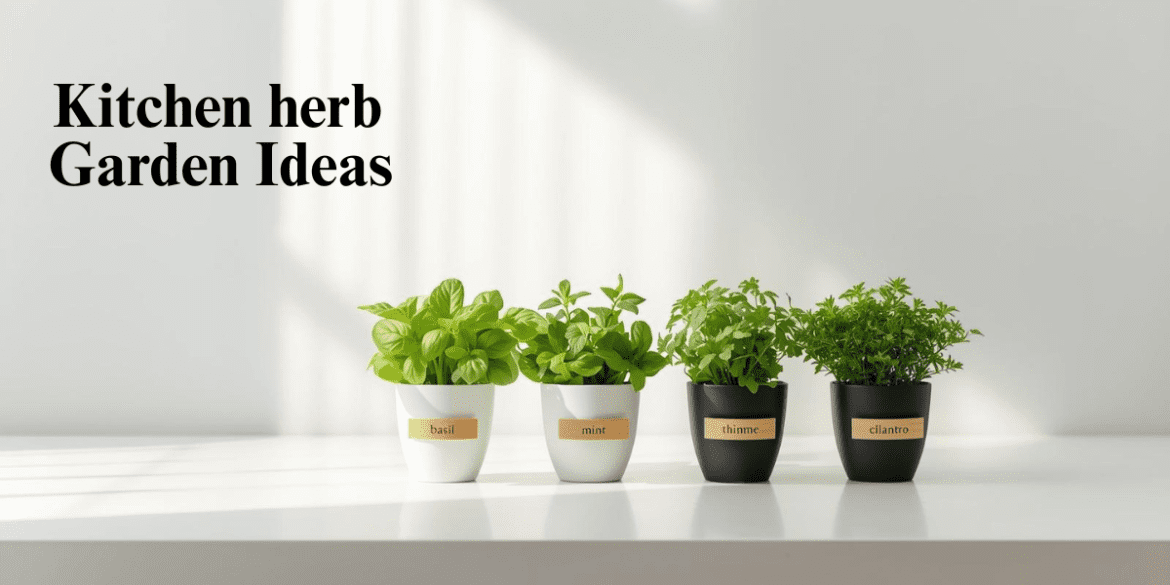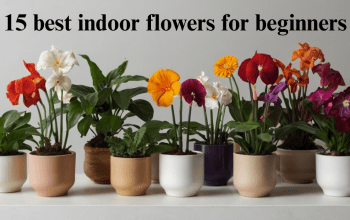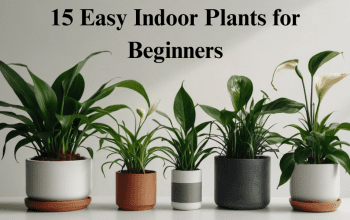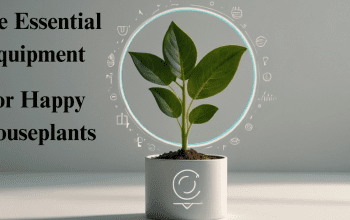Let’s be honest—we’ve all had that moment where we’re halfway through cooking a recipe, only to realize it calls for fresh basil or just a sprig of rosemary. And what do we do? Either run to the store in a panic (and end up buying way more than we need) or settle for the sad little jar of dried herbs that’s been sitting in the cabinet since… well, let’s not talk about how long.
Now imagine this: instead of panic-buying overpriced basil, you just turn around, snip a few leaves from a cheerful green pot on your kitchen counter, and boom—your pasta suddenly tastes like something straight out of a cooking show. That’s the magic of having a kitchen herb garden.
But here’s the best part—it’s not just about saving a grocery trip or flexing your inner Gordon Ramsay. Growing herbs indoors is surprisingly easy, super affordable, and honestly… kind of fun. Plus, it instantly makes your kitchen feel more alive. (There’s just something about a fresh mint plant on the windowsill that screams “yes, I am a sophisticated adult who has their life together.”)
In this guide, we’re diving deep into all the best kitchen herb garden ideas—from classic countertop pots to vertical gardens that save space, DIY setups that cost almost nothing, and even clever design tricks to make your kitchen both practical and Pinterest-worthy. Whether you’ve got a tiny apartment or a chef’s dream kitchen, there’s a way to grow fresh herbs right where you cook.
So grab your apron (or just your coffee mug, no judgment)—let’s get into it.
Kitchen Herbs: The Stars of Your Indoor Garden
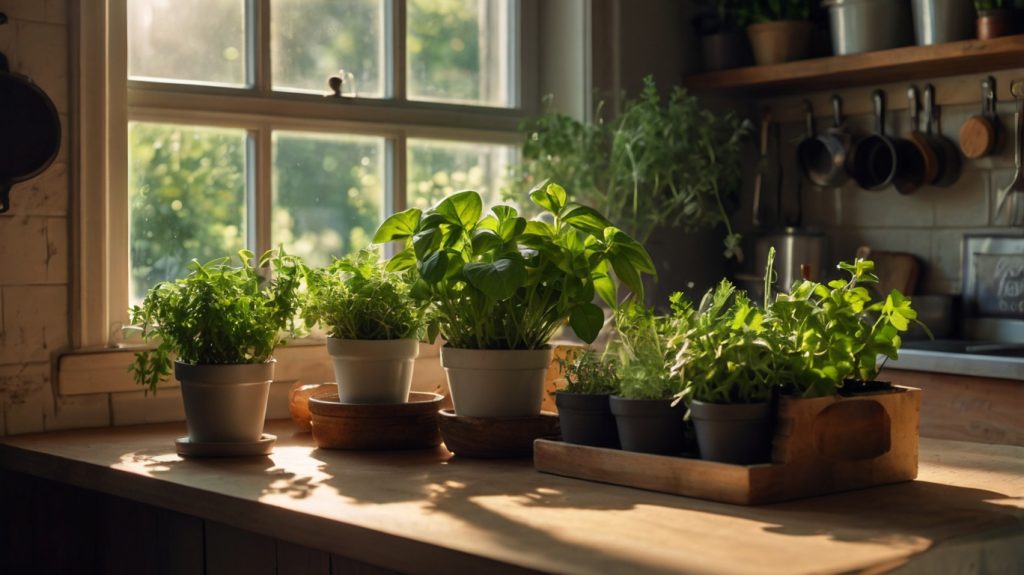
Here’s the thing about kitchen herbs—they’re the unsung heroes of home cooking. Sure, salt and pepper get all the credit, but throw in a few fresh basil leaves or a sprinkle of chopped parsley and suddenly your Tuesday-night dinner looks (and tastes) Michelin-star worthy.
But which herbs deserve a spot in your kitchen? Let’s run through the all-stars:
1: Basil – The king of pesto, pasta sauces, and basically every Italian dish. Bonus: it smells so good you might “accidentally” sniff it more than you cook with it.
2: Mint – Freshens drinks, desserts, and even salads. (Also, handy for pretending you made a fancy cocktail when it’s really just lemonade with leaves.)
Rosemary – Perfect for roasting potatoes, chicken, or making your house smell like you live in a countryside cottage.
3: Parsley – The herb everyone underestimates, but it adds brightness to almost anything. Stop ignoring it—it’s not just garnish.
4: Cilantro (Coriander) – You either love it or think it tastes like soap. If you’re in the love camp, it’s a taco essential.
5: Chives, Dill, Oregano, Thyme – The supporting cast that rounds out your kitchen herb garden like a dream team.
The best part? Herbs are compact. They don’t need an entire yard; just a little sun, some love, and they’ll reward you with fresh flavor at your fingertips.
Growing Herbs in the Kitchen: From Windowsills to Wow
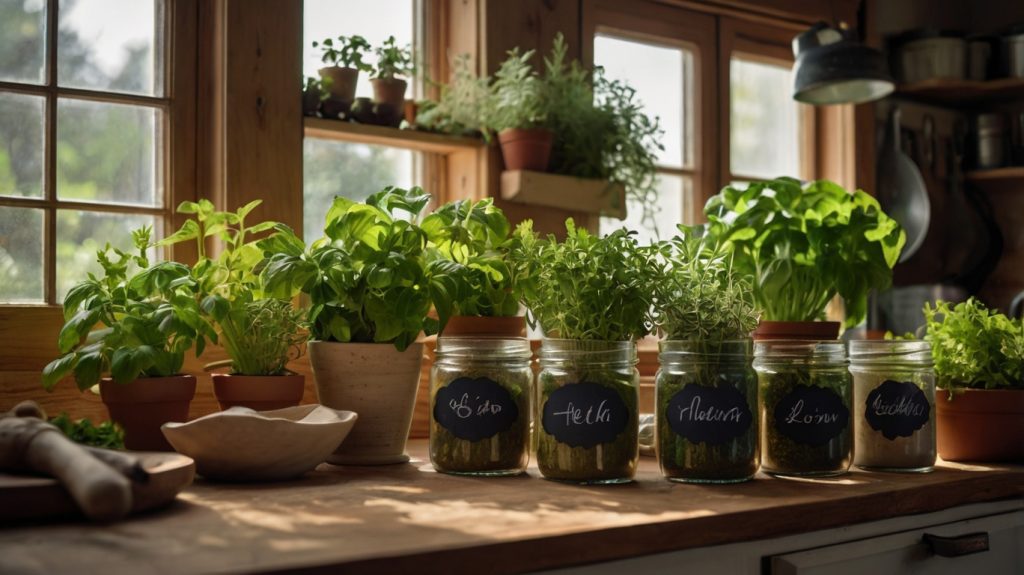
Now, let’s tackle the “how.” Growing herbs indoors is way less intimidating than people think. You don’t need a green thumb—you just need a sunny spot, some soil, and a little consistency (don’t worry, the plants won’t judge your life choices the way humans do).
Step 1: Pick Your Spot
Your herbs need at least 4–6 hours of sunlight a day. A sunny windowsill is perfect. No sunny windows? Don’t panic—cheap LED grow lights can turn your kitchen counter into a mini farm.
Step 2: Choose Containers
This is where you get to be creative. Mason jars, ceramic pots, tin cans, or even hanging baskets—anything works as long as it has drainage. (Pro tip: if it can’t drain, you’re just asking for swampy soil and sad plants.)
Step 3: Soil & Planting
Use well-draining potting soil—not dirt from your backyard. Plant seeds if you’re patient, or buy small starter plants if you want that instant gratification moment of greenery.
Step 4: Watering
Most herbs like soil that’s moist but not soggy. Think of it like giving them a drink, not a bath. Stick your finger in the soil—if it feels dry about an inch down, it’s time.
Step 5: Harvesting
Snip herbs often—it actually makes them grow more. Plus, nothing feels cooler than “harvesting” fresh basil while wearing pajamas at 2 PM.
Here’s the kicker: once you start, it’s addictive. Before long, you’ll go from “I just want some basil for pizza” to “maybe I should grow a full salad bar on my windowsill.” And honestly? That’s the best kind of kitchen obsession to have.
Herb Garden for Kitchen Counter: Freshness at Arm’s Reach
Imagine this: you’re stirring a pot of soup, it smells good, but it’s missing something. Instead of running to the fridge (and discovering that the parsley you bought last week has tragically turned into green mush), you simply lean over, snip some fresh parsley from a cheerful pot sitting right on your kitchen counter, and voilà—your soup levels up instantly.
That’s the magic of a kitchen counter herb garden. It’s fresh flavor, right where you cook. Plus, it doubles as décor—tiny green plants bring a burst of life to even the most basic kitchen setups.
The best herbs for counters? Basil, chives, parsley, mint, or thyme—small, compact, and ready to grow happily in little pots. Just make sure your counter spot gets good light. If not, a slim grow light can fit under your cabinets and turn your counter into a gourmet garden station.
Pro tip: Group herbs with similar needs together (like basil and parsley, which both love moisture). This way, your watering routine doesn’t feel like you’re running a full-scale farm.
Kitchen Herb Garden Layout: Function Meets Aesthetic
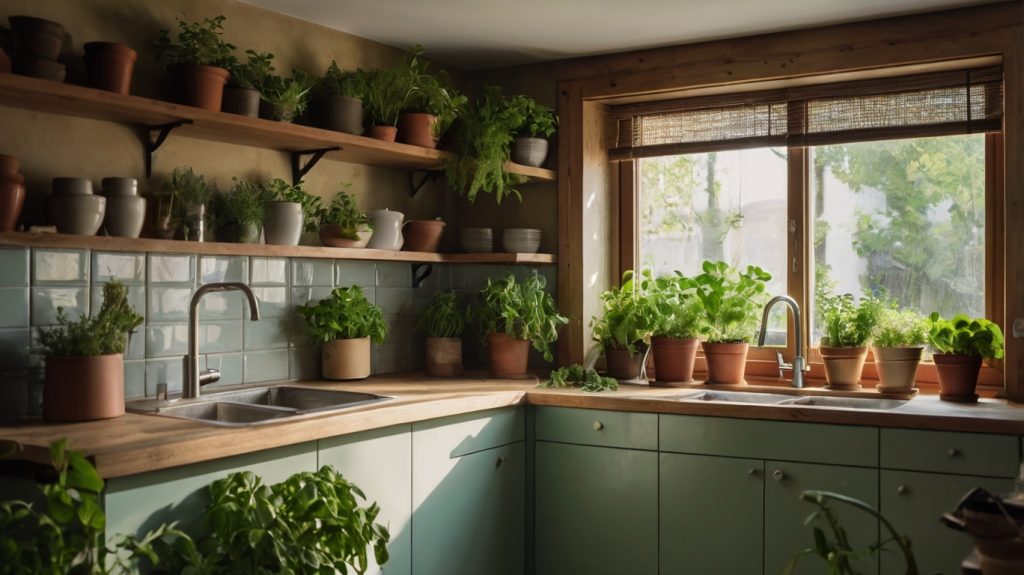
Now, let’s talk design—because yes, even your herbs deserve a little interior styling. A good kitchen herb garden layout isn’t just about cramming plants wherever they fit; it’s about balancing convenience with style.
Here are a few smart layout ideas:
1: The Windowsill Lineup – A classic. Herbs lined up like little green soldiers in matching pots. Simple, practical, and easy to care for.
2: Tiered Stands – Use a tiered plant stand to fit more herbs in less space. Plus, it adds that “Pinterest-y” vibe without much effort.
3: Wall-Mounted Shelves – A vertical approach keeps your counters clear while still keeping herbs close to the action.
4: Cluster Corners – Dedicate one corner of your counter to a mini “herb jungle.” It looks intentional and keeps everything in one place.
Think of your layout as a mix of easy reach + eye candy. Your herbs should be close enough to use while cooking, but also arranged in a way that makes your kitchen feel like a cozy little café.
Herb Containers for Kitchen: Style Meets Practicality
Let’s be real—half the fun of growing herbs indoors is picking the containers. And the best part? You don’t need to stick to boring terracotta pots (unless you’re into that rustic farmhouse look).
Here are some fun container ideas for your kitchen herbs:
1: Mason Jars – Cute, cheap, and Instagram-worthy. Just add small stones at the bottom for drainage.
2: Tin Cans – Upcycle old coffee or tea tins for a quirky, vintage look. Bonus points if you label them with chalk paint.
3: Ceramic Pots – Sleek, modern, and available in endless colors. Perfect if you want a minimalist vibe.
4: Hanging Baskets or Wall Planters – Save counter space while creating a green feature wall.
5: DIY Containers – Old mugs, teapots, even colanders can become creative plant homes. (Because who doesn’t want to say, “Oh yes, my basil lives in a teapot”?)
Just remember the golden rule: drainage holes are non-negotiable. No herb enjoys wet feet. If your dream container doesn’t have holes, use a liner pot inside or add a layer of pebbles at the bottom.
With the right containers, your herbs won’t just be functional—they’ll be little design accents that make your kitchen look fresh and full of personality.
Kitchen Window Herb Garden Ideas: Nature’s Curtain Upgrade
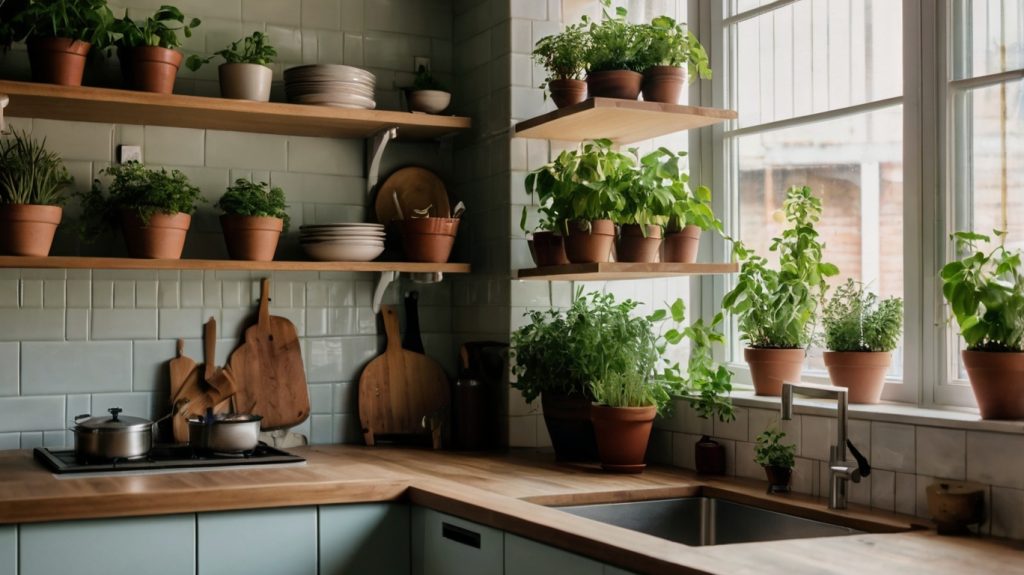
Who needs boring curtains when you can have a row of fragrant, edible greenery dancing in the sunlight?
A kitchen window herb garden is one of the most practical (and aesthetic) ways to grow herbs indoors. It’s like having a mini farmer’s market right where you do the dishes.
Here are some brilliant ideas to get you started:
1: Classic Windowsill Lineup – The OG setup. Line up small pots of basil, parsley, and chives, and you’ve got yourself a windowsill buffet.
2: Hanging Jars – Attach mason jars to a wooden board and mount it against the window. The light streams through the glass, giving your kitchen that “Pinterest-y urban jungle” vibe.
3: Floating Shelves – Install slim shelves across your window and stack herbs vertically. Bonus: it doubles as natural sun-filtering décor.
4: Herb Curtain Rod – Yes, this is a thing. Use a tension rod to hang small planters in front of your window—like a leafy, edible curtain.
Not only do window herb gardens save counter space, but they also thrive with natural light. And let’s be honest, nothing feels cooler than reaching over the sink mid-cooking to grab a sprig of fresh thyme like you’re starring in your own cooking show.
Kitchen Garden Herb Kit: Gardening Made Foolproof
So maybe you want fresh herbs, but the idea of figuring out soil types, drainage, and watering schedules feels… overwhelming. Enter the kitchen garden herb kit—basically gardening on “easy mode.”
These kits usually come with everything you need: seeds, soil pods, containers, and sometimes even built-in grow lights. All you have to do is assemble, water, and wait for the magic. They’re like the meal kits of the plant world—no guesswork, just results.
There are a few types of kits to explore:
1: Starter Kits with Seeds – Great for beginners who want the joy of watching things sprout.
2: Hydroponic Kits – These are high-tech little wonders where herbs grow in water with nutrients (no soil, no mess, just sleek sci-fi vibes).
3: Smart Garden Kits – Some even remind you when to water via an app. Yes, we live in the future.
A kitchen herb kit is perfect if you want zero stress and maximum freshness. Plus, they make amazing gifts—because who wouldn’t want a box that says, “Here’s a basil plant you didn’t know you needed, but now you can’t live without”?
Kitchen Herb Pots: Where Function Meets Style
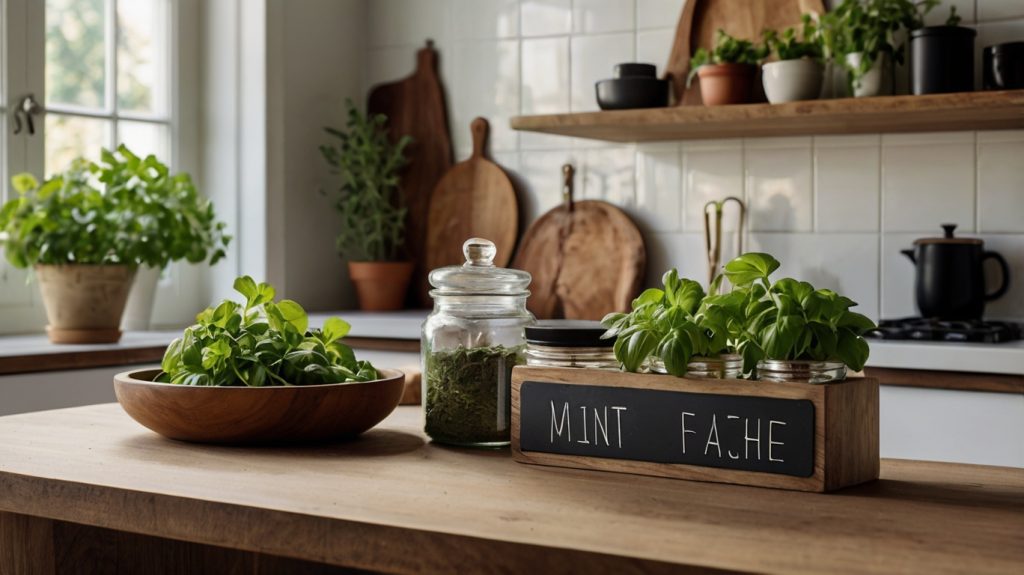
If your herbs are the stars, then pots are the stage. And trust me, the right kitchen herb pots can completely change the look of your space.
Here’s what you want to keep in mind:
1: Self-Watering Pots – Ideal if you’re forgetful (aka, human). These pots store water at the bottom and let the plant drink when it’s thirsty.
2: Ceramic or Terracotta Pots – Classic choices that look timeless. Terracotta helps prevent overwatering by allowing soil to “breathe.”
3: Glass Pots or Clear Planters – Great for hydroponics or decorative setups where you can see the roots doing their thing.
4: Matching Sets – Having uniform pots creates a sleek, organized look—like your kitchen herbs are part of a chic, green army.
5: Creative Containers – Old mugs, vintage bowls, or quirky thrift finds can double as pots. Just add drainage or use them as outer “cachepots.”
Pro tip: Label your pots, especially if you’re growing multiple green friends that look suspiciously alike. (Trust me, sprinkling mint into spaghetti sauce instead of basil is… an experience you don’t want.)
At the end of the day, your kitchen herb pots aren’t just plant homes—they’re décor pieces. Done right, they’ll make your herbs look as stylish as they taste.
Final Thoughts: Your Kitchen, Your Herb Haven
Well, look at us—we’ve gone on quite the herb-filled adventure together, haven’t we? We started by laughing at that sad, dried oregano hiding in the back of your spice cabinet (we both know it’s older than some friendships), and ended up building a full-blown plan for a fresh, thriving kitchen herb garden that makes your space smell, look, and taste amazing.
Here’s the recap of your new green life plan:
- You met the MVP herbs—basil, mint, parsley, rosemary, and their flavorful friends.
- You learned how easy it is to grow herbs in your kitchen, even if your thumb is currently more Wi-Fi-colored than green.
- We explored the convenience of a countertop herb garden, the charm of different kitchen layouts, and the style points you get from picking the right herb containers.
- Then we spiced it up with window garden ideas, geeked out over herb kits, and picked out pots worthy of Instagram fame
And through all of it, one thing became very clear: a kitchen herb garden isn’t just about cooking—it’s about creating a little oasis of life right where you spend so much of your day. It saves you money, makes your food taste incredible, and gives you that small-but-satisfying joy of snipping a leaf of basil you grew yourself.
The best part? You don’t need a mansion-sized kitchen, years of gardening wisdom, or some magical green thumb. All you need is a sunny spot (or a grow light), a bit of consistency, and the willingness to let your kitchen double as a mini garden.
So, whether you start with one lonely pot of mint or dive headfirst into a full windowsill jungle, just remember: the journey is supposed to be fun. Don’t stress over perfection—your plants won’t. They’ll just keep growing, one leaf at a time, reminding you that freshness and flavor are literally at your fingertips.
Now go on—your pasta, cocktails, and salads are waiting for their glow-up. 🌿✨
FAQs
The champions of kitchen gardening are basil, mint, parsley, thyme, oregano, chives, and cilantro. They’re compact, aromatic, and thrive indoors with a bit of light and care. Plus, they’re the herbs you’ll actually use in everyday cooking—so no wasted space on “just-for-show” plants.
Think of it like stocking a spice rack, but fresher. Every kitchen should have basil (for pasta and pizza), mint (for tea or mojitos—you know, priorities), parsley (for garnish and flavor), rosemary (for roasted potatoes and chicken), and cilantro (for tacos and curries). With these five, you can upgrade almost any dish.
If you’re new to gardening and don’t want high-maintenance green divas, start with mint, basil, parsley, and chives. They grow quickly, bounce back if you forget a watering or two, and give you that instant “I’m a successful plant parent” feeling.
Most herbs love at least 4–6 hours of sunlight a day, so a sunny windowsill is prime real estate. But if your kitchen feels more like a cave, don’t panic—grow lights are a great backup. Herbs like mint and parsley are also more forgiving in lower light conditions.
Mint wins this crown, hands down. It grows fast, doesn’t fuss much, and spreads like wildfire (sometimes too much, so keep it in its own pot). Basil is another beginner favorite—it grows quickly and rewards you with plenty of leaves for cooking.
Aside from herbs, you can keep small leafy greens (like lettuce), dwarf chili plants, or even aloe vera (handy for kitchen burns). Decorative plants like pothos and spider plants also do well in kitchens—they clean the air and don’t mind the occasional steam cloud from your cooking.
If grown indoors and cared for properly, herbs can last months to years. Perennial herbs like rosemary, thyme, and mint can keep going year after year. Annuals like basil may only last one growing season but can give you plenty of harvests in that time.
Most herbs sprout within 7–21 days after planting seeds. You can usually start harvesting light clippings within 4–6 weeks. Fast growers like basil, parsley, and cilantro will keep producing as long as you trim them regularly. Think of it as “snip to keep them alive.”
